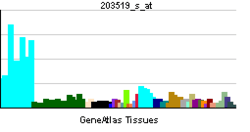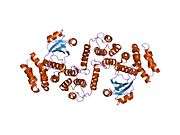UPF2
Regulator of nonsense transcripts 2 is a protein that in humans is encoded by the UPF2 gene.[4][5][6]
Function
This gene encodes a protein that is part of a post-splicing multiprotein complex, the exon junction complex, involved in both mRNA nuclear export and mRNA surveillance. mRNA surveillance detects exported mRNAs with truncated open reading frames and initiates nonsense-mediated mRNA decay (NMD). When translation ends upstream from the last exon-exon junction, this triggers NMD to degrade mRNAs containing premature stop codons. This protein is located in the perinuclear area. It interacts with translation release factors and the proteins that are functional homologs of yeast Upf1p and Upf3p. Two splice variants have been found for this gene; both variants encode the same protein.[6]
Interactions
UPF2 has been shown to interact with UPF1,[4][7][8][9][10] UPF3A[7][10] and UPF3B.[7][10][11][12]
References
- ↑ "Diseases that are genetically associated with UPF2 view/edit references on wikidata".
- ↑ "Human PubMed Reference:".
- ↑ "Mouse PubMed Reference:".
- 1 2 Mendell JT, Medghalchi SM, Lake RG, Noensie EN, Dietz HC (Dec 2000). "Novel Upf2p orthologues suggest a functional link between translation initiation and nonsense surveillance complexes". Molecular and Cellular Biology. 20 (23): 8944–57. doi:10.1128/MCB.20.23.8944-8957.2000. PMC 86549
 . PMID 11073994.
. PMID 11073994. - ↑ Serin G, Gersappe A, Black JD, Aronoff R, Maquat LE (Jan 2001). "Identification and characterization of human orthologues to Saccharomyces cerevisiae Upf2 protein and Upf3 protein (Caenorhabditis elegans SMG-4)". Molecular and Cellular Biology. 21 (1): 209–23. doi:10.1128/MCB.21.1.209-223.2001. PMC 88795
 . PMID 11113196.
. PMID 11113196. - 1 2 "Entrez Gene: UPF2 UPF2 regulator of nonsense transcripts homolog (yeast)".
- 1 2 3 Lejeune F, Li X, Maquat LE (Sep 2003). "Nonsense-mediated mRNA decay in mammalian cells involves decapping, deadenylating, and exonucleolytic activities". Molecular Cell. 12 (3): 675–87. doi:10.1016/S1097-2765(03)00349-6. PMID 14527413.
- ↑ Schell T, Köcher T, Wilm M, Seraphin B, Kulozik AE, Hentze MW (Aug 2003). "Complexes between the nonsense-mediated mRNA decay pathway factor human upf1 (up-frameshift protein 1) and essential nonsense-mediated mRNA decay factors in HeLa cells". The Biochemical Journal. 373 (Pt 3): 775–83. doi:10.1042/BJ20021920. PMC 1223536
 . PMID 12723973.
. PMID 12723973. - ↑ Yamashita A, Ohnishi T, Kashima I, Taya Y, Ohno S (Sep 2001). "Human SMG-1, a novel phosphatidylinositol 3-kinase-related protein kinase, associates with components of the mRNA surveillance complex and is involved in the regulation of nonsense-mediated mRNA decay". Genes & Development. 15 (17): 2215–28. doi:10.1101/gad.913001. PMC 312771
 . PMID 11544179.
. PMID 11544179. - 1 2 3 Lykke-Andersen J, Shu MD, Steitz JA (Dec 2000). "Human Upf proteins target an mRNA for nonsense-mediated decay when bound downstream of a termination codon". Cell. 103 (7): 1121–31. doi:10.1016/S0092-8674(00)00214-2. PMID 11163187.
- ↑ Lehner B, Sanderson CM (Jul 2004). "A protein interaction framework for human mRNA degradation". Genome Research. 14 (7): 1315–23. doi:10.1101/gr.2122004. PMC 442147
 . PMID 15231747.
. PMID 15231747. - ↑ Lykke-Andersen J (Dec 2002). "Identification of a human decapping complex associated with hUpf proteins in nonsense-mediated decay". Molecular and Cellular Biology. 22 (23): 8114–21. doi:10.1128/MCB.22.23.8114-8121.2002. PMC 134073
 . PMID 12417715.
. PMID 12417715.
Further reading
- Wilson KF, Fortes P, Singh US, Ohno M, Mattaj IW, Cerione RA (Feb 1999). "The nuclear cap-binding complex is a novel target of growth factor receptor-coupled signal transduction". The Journal of Biological Chemistry. 274 (7): 4166–73. doi:10.1074/jbc.274.7.4166. PMID 9933612.
- Nagase T, Kikuno R, Ishikawa KI, Hirosawa M, Ohara O (Feb 2000). "Prediction of the coding sequences of unidentified human genes. XVI. The complete sequences of 150 new cDNA clones from brain which code for large proteins in vitro". DNA Research. 7 (1): 65–73. doi:10.1093/dnares/7.1.65. PMID 10718198.
- Lykke-Andersen J, Shu MD, Steitz JA (Dec 2000). "Human Upf proteins target an mRNA for nonsense-mediated decay when bound downstream of a termination codon". Cell. 103 (7): 1121–31. doi:10.1016/S0092-8674(00)00214-2. PMID 11163187.
- Yamashita A, Ohnishi T, Kashima I, Taya Y, Ohno S (Sep 2001). "Human SMG-1, a novel phosphatidylinositol 3-kinase-related protein kinase, associates with components of the mRNA surveillance complex and is involved in the regulation of nonsense-mediated mRNA decay". Genes & Development. 15 (17): 2215–28. doi:10.1101/gad.913001. PMC 312771
 . PMID 11544179.
. PMID 11544179.
- Lykke-Andersen J, Shu MD, Steitz JA (Sep 2001). "Communication of the position of exon-exon junctions to the mRNA surveillance machinery by the protein RNPS1". Science. 293 (5536): 1836–9. doi:10.1126/science.1062786. PMID 11546874.
- Lejeune F, Ishigaki Y, Li X, Maquat LE (Jul 2002). "The exon junction complex is detected on CBP80-bound but not eIF4E-bound mRNA in mammalian cells: dynamics of mRNP remodeling". The EMBO Journal. 21 (13): 3536–45. doi:10.1093/emboj/cdf345. PMC 126094
 . PMID 12093754.
. PMID 12093754.
- Lykke-Andersen J (Dec 2002). "Identification of a human decapping complex associated with hUpf proteins in nonsense-mediated decay". Molecular and Cellular Biology. 22 (23): 8114–21. doi:10.1128/MCB.22.23.8114-8121.2002. PMC 134073
 . PMID 12417715.
. PMID 12417715.
- Chiu SY, Serin G, Ohara O, Maquat LE (Jan 2003). "Characterization of human Smg5/7a: a protein with similarities to Caenorhabditis elegans SMG5 and SMG7 that functions in the dephosphorylation of Upf1". Rna. 9 (1): 77–87. doi:10.1261/rna.2137903. PMC 1370372
 . PMID 12554878.
. PMID 12554878.
- Gehring NH, Neu-Yilik G, Schell T, Hentze MW, Kulozik AE (Apr 2003). "Y14 and hUpf3b form an NMD-activating complex". Molecular Cell. 11 (4): 939–49. doi:10.1016/S1097-2765(03)00142-4. PMID 12718880.
- Schell T, Köcher T, Wilm M, Seraphin B, Kulozik AE, Hentze MW (Aug 2003). "Complexes between the nonsense-mediated mRNA decay pathway factor human upf1 (up-frameshift protein 1) and essential nonsense-mediated mRNA decay factors in HeLa cells". The Biochemical Journal. 373 (Pt 3): 775–83. doi:10.1042/BJ20021920. PMC 1223536
 . PMID 12723973.
. PMID 12723973.
- Lejeune F, Li X, Maquat LE (Sep 2003). "Nonsense-mediated mRNA decay in mammalian cells involves decapping, deadenylating, and exonucleolytic activities". Molecular Cell. 12 (3): 675–87. doi:10.1016/S1097-2765(03)00349-6. PMID 14527413.
- Ohnishi T, Yamashita A, Kashima I, Schell T, Anders KR, Grimson A, Hachiya T, Hentze MW, Anderson P, Ohno S (Nov 2003). "Phosphorylation of hUPF1 induces formation of mRNA surveillance complexes containing hSMG-5 and hSMG-7". Molecular Cell. 12 (5): 1187–200. doi:10.1016/S1097-2765(03)00443-X. PMID 14636577.
- Kadlec J, Izaurralde E, Cusack S (Apr 2004). "The structural basis for the interaction between nonsense-mediated mRNA decay factors UPF2 and UPF3". Nature Structural & Molecular Biology. 11 (4): 330–7. doi:10.1038/nsmb741. PMID 15004547.
- Lehner B, Sanderson CM (Jul 2004). "A protein interaction framework for human mRNA degradation". Genome Research. 14 (7): 1315–23. doi:10.1101/gr.2122004. PMC 442147
 . PMID 15231747.
. PMID 15231747.
- Lejeune F, Ranganathan AC, Maquat LE (Oct 2004). "eIF4G is required for the pioneer round of translation in mammalian cells". Nature Structural & Molecular Biology. 11 (10): 992–1000. doi:10.1038/nsmb824. PMID 15361857.
PDB gallery |
|---|
|
| 1uw4: THE STRUCTURAL BASIS OF THE INTERACTION BETWEEN NONSENSE MEDIATED DECAY FACTORS UPF2 AND UPF3 |
|
|


 . PMID 11073994.
. PMID 11073994. . PMID 11113196.
. PMID 11113196. . PMID 12723973.
. PMID 12723973. . PMID 11544179.
. PMID 11544179. . PMID 15231747.
. PMID 15231747. . PMID 12417715.
. PMID 12417715. . PMID 11544179.
. PMID 11544179. . PMID 12093754.
. PMID 12093754. . PMID 12417715.
. PMID 12417715. . PMID 12554878.
. PMID 12554878. . PMID 12723973.
. PMID 12723973. . PMID 15231747.
. PMID 15231747.